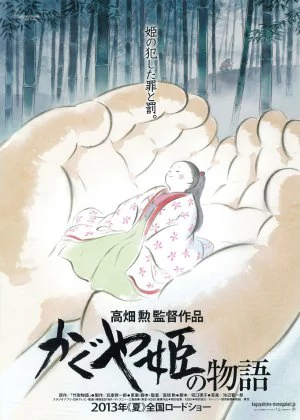The Tale of Princess Kaguya

While the world is mourning for Hayao Miyazaki's retirement, another one of Ghibli's monuments is more than likely celebrating the release of his final film. More than 5 years in the making, The Tale of Princess Kaguya [Kaguyahime no Monogatari] sees Isao Takahata returning to the big screen. The result is remarkable, though not entirely without fault. Still, Takahata demonstrates one final time why he's a bigger loss to the world of animation than Miyazaki could ever dream to be.

Even though Miyazaki's output is a bit more consistent across the board, Takahata (Omohide Poro Poro, Hotaru no Haka) made the better films. While Miyazaki enjoys a broader commercial appeal, Takahata has done more to push the boundaries of people's expectations when it comes to animation. Excelling in maturity and pushing forward different art styles for different projects, Takahata is clearly the more visionary of the two and, at least for me, counts as a greater loss.
The Tale of Princess Kaguya is based on The Tale of the Bamboo Cutter, the oldest known Japanese narrative to date. It's a classic Japanese tale about a princess born from a bamboo sprout and raised by a couple of farmers living close by the bamboo forest. While Takahata did play around with the original story, the adaptation feels like it could have used some extra rejuvenation. While there lies plenty of beauty in the original story, it's also a bit repetitive and long-winding and it could have done with some extra cuts.
In her early years, the princess leads a happy and care-free life amongst the fields and hills where the farmers live. But when her earthly parents decide to move to the city to let the princess flourish in a more civilized and cultured environment, she becomes more and more depressed. She declines all her suitors and even ends up turning a cold shoulder to the emperor. All the while her parents wonder why the princess can't get used to the city life.

Even though Ghibli has a recognizable visual style that most of their films adhere to, Takahata himself broke free from that when he made Hohokekyo Tonari no Yamada-kun. The Tale of Princess Kaguya feels like a continuation of that sober yet delicate hand-painted look. While there's a bit more detail here, the film looks as if an old Japanese painting just came to life. Lines and contours don't always connect and characters lack superficial details, but the beautiful water color style easily overcomes that.
The true beauty lies in the animation itself though, which is of extraordinary quality. Just as Takahata managed to do with Yamada-kun, the animation lends a certain depth and detail to the visuals that transcends the need for a detailed art style. The way characters move and interact with their environment is spot on, unique to the work of Takahata. Sadly the animation is let down by a camera that's a bit too static for its own good. While it lends a more painting-like quality to the film, the lack of different camera angles or camera movement becomes just a little dull after a while. Especially when compared to the 3 or 4 scenes where Takahata does let the camera run free. It's a shame because these scenes do manage to lift the rigidity embedded in the narrative.
Once again Ghibli (and former Kitano) regular Joe Hisaishi is responsible for the soundtrack. The music is a subtle mix of Hisaishi's trademark piano sound with more traditional Japanese music, resulting in a beautiful yet slightly unadventurous set of tracks. There are a couple of songs (co-written by Takahata himself) that add to the vintage feel of the film, but they are few and far between. The dub is, as can be expected from a Ghibli film, top notch. As far as I know there's only a Japanese dub available, which in this case is essential to get the most out of the film.

While all the ingredients are here for a full-blown masterpiece, The Tale of Princess Kaguya has some serious pacing issues. While the intro and finale are both excellent, the middle part of the film is repetitive and drags on for too long. The sequence with the 5 suitors in particular is too drawn-out and needlessly holds up the film. This kind of repetition is not unusual in older stories, but without new angles or new insights it gets boring pretty fast. It's a shame, because with some cutting in the middle part the film could've been a lot better.
The Tale of Princess Kaguya is still a marvel to behold and definitely worth your time, but it's also a film that feels like a natural end to Takahata's career. While Miyazaki finished on top of his game, Takahata's latest feels as if a decline in quality has settled in. Visually it's one of the bravest and most unique things you'll see coming out of Japan this year, but there's an overall lack of vitality and some pacing issues halfway through that work against the abundant beauty present. Ghibli fans shouldn't be too worried, but unless you have a soft spot for animation and classic Japanese tales, don't expect an absolute masterpiece.